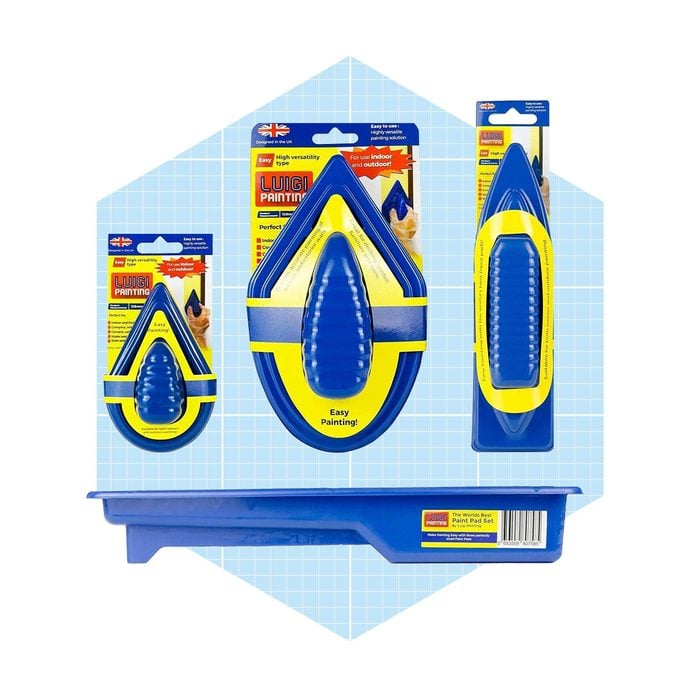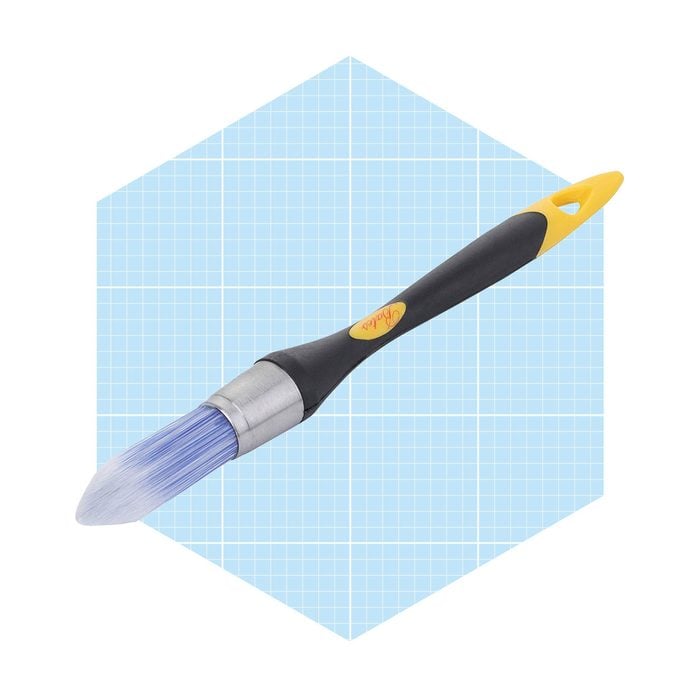Best Overall
Shortcut Angle Sash Paint Brush
One of the best things you can have in your painting tool kit is an angled brush with a flexible handle, like the Wooster Shortcut. Wooster makes high-quality brushes with bargain prices, and the 2-inch Shortcut is specifically designed for trim and tight spaces. It’s one of the best paint edging tools that also happens to be extremely affordable. The angled bristles and flexible grip provide greater control when maneuvering tight spaces.
The sharp angle gives this paint edging tool an excellent line of sight, allowing you to focus on where the tip of the brush meets the trim. The short handle, which features a convenient peg hook on the end, is ideal for reaching into tighter quarters or cutting in around irregular shapes. Its poly-blend bristles are compatible with all paints and stains; and it cleans easily in water (or solvent, if you used oil-based paint).
Pros
- Perfect for painting trim or edging a wall
- Provides smooth uniform coverage
- The angled bristles provide greater control
- Cleans easily in water, or solvent if you used oil-based paint
- Affordable
Cons
- Some may not like the short handle
Best Budget
Edward Tools Paint Trim Guard
The most basic tool to aid in trim painting is a long metal guard, like this Edward Tools version. The stainless steel blade is durable, rust-resistant and easy to clean. The thin blade minimizes visual obstruction, allowing you to get as close as needed to ensure a quality edge.
Here’s a helpful professional painters tip when using this edge painter tool: Some people make the mistake of pulling the guard across the trim when resetting. This movement draws paint across the trim surface, ruining the entire effect. Avoid this by pulling out and away at an angle, wiping any accumulated paint from the shield with a rag. It only takes a second or so to do this, but it’s faster than pre-taping or trying to clean up messy trim after the fact.
Pros
- Very affordable
- The stainless steel blade is durable and rust-resistant
- Easy to clean
- Comes with a lifetime warranty
Cons
- Only 12 inches wide, might be too small for big paint jobs
Best Paint Brush Attachment
Cut-N-Edge Brush Edger Guard
The Boxtown Team Cut-N-Edge combines the concept of a shield and a brush into a single tool, perfect for edging or painting trim. In fact, the Cut-N-Edge uses two shields that wrap around the brush, sandwiching the bristles. The compression is adjustable, allowing you to control the stiffness of the bristle edge. Tighter bristles mean very thin lines for precision edging, while looser bristles allow for flexibility and wider coverage when painting trim.
The plastic body extends to cover the end of the bristles, making it a perfect protective storage system to preserve the brush. It has teeth to aid in brush cleaning and a side hook to permit in-can support while taking a break.
Pros
- Length can easily be trimmed to fit your brush
- Incredible value
- Side hook can be removed if it gets in the way
- Excellent for painters with unsteady hands
Cons
- Only 2.5 inches wide
Best Paint Edging Roller
Smart Edge Paint Roller
The Wagner Smart Edge Paint Roller has a shield-and-roller design, and holds a reservoir of paint inside its handle. The paint flow is controlled by a thumb-activated trigger. This dramatically reduces the number of times you need to re-wet the three-inch roller—as the roller begins to go dry, simply give it a squeeze and keep working. The reservoir holds up to six ounces of paint, which Wagner estimates covers up to 96 linear feet of edging.
It should be noted that the paint storage system does add weight—not too much, but enough that you’ll begin to feel it over the course of painting a room, especially if you’re working overhead. The same design that allows it to store paint in the handle makes it easier to clean up. Simply squeeze excess paint back into the can, then thread the provided cleaning adapter to a garden hose or threaded faucet and flush water through the roller.
Pros
- Smart design
- Easy to clean
- Saves time
Cons
- Pricier than some other options
Best Paint Edger
Paint Edger for Flat Surfaces
Another popular trim tool is the Shur-Line Paint Edger Plus. The Shur-Line is essentially a woven-fiber pad with a pair of wheels on one edge. By rolling the wheels along the trim, you get a straight line. When it comes to tools for edging paint, this one has a good line of sight so you can easily keep an eye on your work. The woven fibers leave no individual brush marks, helping the trim paint blend in with roller-applied body paint on the wall.
Pros
- Can be used by hand or pole-mounted to reach high ceilings
- Easy to clean
- Ergonomic grip
- Affordable
Cons
- Easily breakable if left at the bottom of a toolbox
Best Paint Pads
Luigi Paint Pad Set
Simply put, paint pads are thin sponges on a plastic handle. They make excellent paint edging tools for novices who may be intimidated by the notion of cutting in edge paint. Luigi’s self-proclaimed “World’s Best Paint Pad” leaves no brush marks, so the edging paint blends well with roller-applied wall paint.
They make it easy to apply an even coat, and with just a bit of lip that extends past the pad edge, they have a very good line of sight to your trim line. This set also stands out for its variety of sizes and angles. Chances are good that no matter what kind of profile you need to paint, one of these pads will be able to tackle it.
Pros
- Leaves no brush marks
- For indoor or outdoor use
- Includes paint tray
Cons
- Sponges hold less paint and require more frequent refilling
- Not as durable as brushes
Best Detailing Brush
Three-Quarter-Inch Trim Brush
The Bates Trim Brush is a very small, specialized brush designed to cut in around trim. This won’t be your primary go-to for edging—it’s too small to paint a wide enough band to easily roll the wall body paint against. (For a primary brush, we recommend the Wooster Shortcut.) This trim brush is best used as a specialty painting tool for particularly tight spaces where a normal 2-inch brush won’t fit.
Pros
- Small enough for precision work
- Lightweight, even when loaded up with paint
- Firm bristles create precise lines
Cons
- Only for small details
Best Painter’s Tape and Dispenser
3M Hand-Masker
We’ve mostly talked about tools to help apply paint. But another strategy for quality edging is to protect the trim or edge wall before painting with painter’s tape. If you opt for that method, it’s worth picking up the 3M Hand-Masker Dispenser. This paint edging tool allows you to put down tape faster and more accurately than you could by eyeballing the straightness on your own.
The 3M Hand-Masker is made to be used with Scotch Blue Painter’s Tape (which is excellent!), but it’s compatible with most brands of painter’s tape, too. It can also be used with hand-masker film, a wider protective material often used when spray painting.
Pros
- Speeds up taping
- Helps you lay tape straight the first time
- Works with most brands of painters tape, so you aren’t limited to 3M branded products
- Easy-grip handle
- Protects a variety of surfaces
Cons
- Works best for straight lines, so not ideal for slightly tilted surfaces or irregular lengths of trim
- Pricey
What to Consider When Buying Paint Edging Tools
When buying paint edging tools, it’s important to consider the following:
Quality Construction: Look for paint edging tools that are well-built and made from durable materials without going overboard on weight. This is especially true for rollers or trim tools that you’ll be using overhead.
Cleanup: Once you’re done using the tool, how long will you spend trying to get it clean? A tool that saves an hour of work but takes an extra 40 minutes to clean isn’t much of a deal. (The exception being disposable tools.)
Line of Sight: When laying down an edge line, it’s vital that you can see where the paint is going. Poorly designed tools block your line of sight to the brush (or roller) and the flat edge you’re working against.
Types of Paint Edging Tools
- Trim Brushes: These are paint brushes with bristles cut on an angle, so you’re able to get right up to the edge.
- Paint Guard: This tool has a thin metal edge with a handle, and the precise blade can save you a lot of time.
- Narrow Trim Brushes: The bristles on this brush come to a point, allowing you to get into tight or awkward spots.
- Paint Pads: Paint pads are essentially thin sponges on a plastic handle.
- Paint Edgers: This edge painter tool is a woven-fiber pad with a pair of wheels on one side.
- Rollers: An edging roller is a miniature version of what you use for the wall body paint.
How We Chose the Best Paint Edging Tools
As shopping experts, our only job is to help you find a winning product. We start with the research and reporting basics—what products are made of, what they look like and how much they cost—to ensure that we’re only recommending the buys that are worth your time and money. Then, we research the features that speak to the product’s quality, taking advice from industry insiders and subject matter experts on what makes a product a smart value (or worthy of a splurge). Finally, we do the work of combing through user reviews to see how real people interact with the product, and if it stands up to the test.
FAQ
Do paint edgers actually work?
Yes, if you use them carefully. Paint edging tools eliminate the need for taping along surfaces. Putting down painter’s tape takes a lot of time, and can pull up bits of paint when you remove it. Edging brushes and tools also help you get clean edges around circular objects like smoke detectors.
Can you edge one day and paint the next?
That can be risky. Letting paint dry overnight and finishing the next day can lead to different shades. For the best results, paint the edges first, then paint the rest of the wall with a roller.
How do you fix messy edges when painting?
Wait for it to dry, then use sandpaper to get rid of the messy spot before you touch it up.
Shop smarter with our expert recommendations for tools, gear and money-saving deals on can’t miss DIY and home products. Sign up for the Stuff We Love newsletter.









